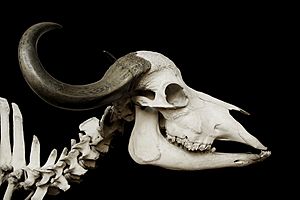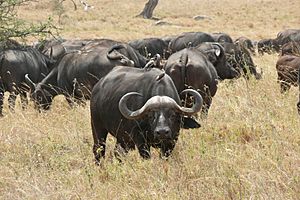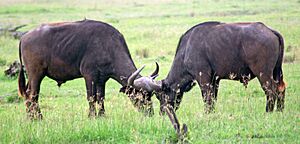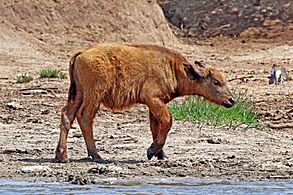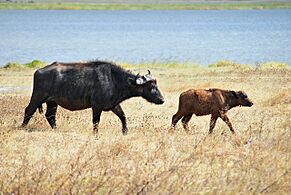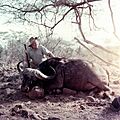African buffalo facts for kids
Quick facts for kids African buffalo |
|
|---|---|
 |
|
| Cape buffalo (S. c. caffer) at Chobe National Park, Botswana with a Cattle egret atop it | |
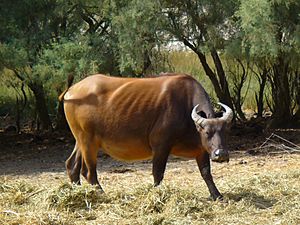 |
|
| Forest buffalo (S. c. nanus) at Réserve Africaine de Sigean, France | |
| Conservation status | |
| Scientific classification | |
| Genus: |
Syncerus
|
| Species: |
caffer
|
| Subspecies | |
|
S. c. caffer |
|
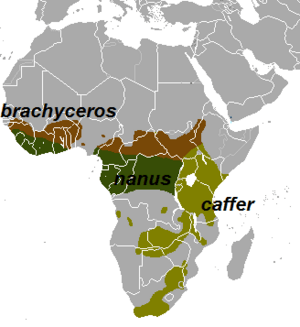 |
|
| Range of the commonly accepted forms of the African buffalo | |

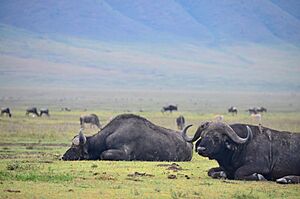
The African buffalo (Syncerus caffer) is a large animal found in sub-Saharan Africa. It belongs to the bovine family, which includes cattle. There are five main types, or subspecies, of African buffalo.
The largest type is the Cape buffalo (Syncerus caffer caffer). It lives in Southern and East Africa. The smallest type is the forest buffalo (S. c. nanus). It lives in the forests of Central Africa and West Africa. Other types include S. c. brachyceros in West Africa and S. c. aequinoctialis in East African savannas.
Adult African buffalo have very special horns. Their horn bases grow together, forming a hard bone shield on top of their head. This shield is called a "boss."
The African buffalo is related to other buffalo species, like the Asian water buffalo. It is not as closely related to animals like American bison or domestic cattle. African buffalo have never been tamed or domesticated. This is probably because they can be very unpredictable.
Wild animals that hunt adult African buffalo include lions, African wild dogs, spotted hyenas, and Nile crocodiles. The Cape buffalo is one of the Big Five game animals. This means it is a popular animal for hunters to seek out.
Contents
What They Look Like
The African buffalo is a very strong and sturdy animal. It can stand from 1.0 to 1.7 meters (3.3 to 5.6 feet) tall at the shoulder. Its body length can be from 1.7 to 3.4 meters (5.6 to 11.2 feet). Their tail can be 70 to 110 centimeters (28 to 43 inches) long.
Compared to other large bovines, the buffalo has a long, thick body. Its legs are short but very strong. Cape buffalo weigh from 425 to 870 kilograms (937 to 1,918 pounds). Males are usually about 100 kg (220 lb) heavier than females. Forest buffalo are much smaller, weighing only 250 to 450 kg (550 to 990 lb).
The buffalo carries its head low, below its back. Its front hooves are wider than its back hooves. This helps support the heavier front part of its body.
Savannah buffalo usually have black or dark brown fur. Older males often have white circles around their eyes and on their face. Females tend to have more reddish fur. Forest buffalo are smaller, about 30-40% less in size. They are reddish-brown with more hair around their ears. Their horns curve back and slightly up. Young buffalo calves of both types have red fur.
The horns of adult male African buffalo are very special. Their bases grow together to form a "boss" or shield. From this boss, the horns spread downwards, then curve upwards and outwards. Sometimes they curve inwards or backwards. For large males, the distance between the horn tips can be over one meter (3.3 feet). The record is 164 cm (64.5 inches).
The horns fully form when the buffalo is 5 or 6 years old. But the boss doesn't become fully hard until they are 8 or 9 years old. Female buffalo horns are smaller, about 10-20% less in size, and they do not have a boss. Forest buffalo horns are smaller than those of savannah buffalo. They are usually less than 40 cm (16 inches) long and almost never form a fused boss.
African buffalo have 52 chromosomes. Other large bovines, like American bison and domestic cattle, have 60 chromosomes. This difference means that African buffalo cannot have hybrid babies with domestic cattle or bison.
Types of African Buffalo
| Image | Subspecies | What They Are Like | Where They Live |
|---|---|---|---|
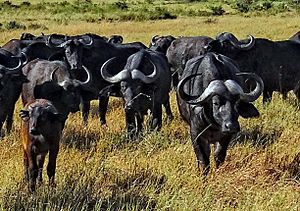 |
Syncerus caffer caffer (the Cape buffalo) | This is the largest type. Large males can weigh up to 870 kg (1,918 lb). Their color is the darkest, almost black. | Southern and East Africa. |
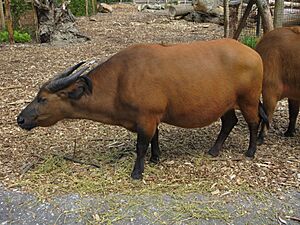 |
S. c. nanus (the forest buffalo, dwarf buffalo or Congo buffalo) | This is the smallest type. They are less than 120 cm (47 inches) tall at the shoulder. They weigh about 270 kg (595 lb), which is similar to a zebra. Their color is red, with darker spots on their head and shoulders. Some scientists think this might be a separate species. | Forest areas of Central and West Africa. |
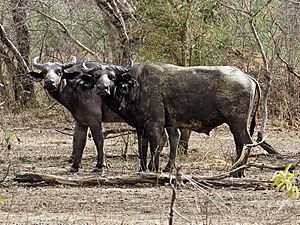 |
S. c. brachyceros (the Sudan buffalo) | This type is in between the Cape and forest buffalo in size. Adults usually weigh up to 400 kg (880 lb). | West Africa |
| S. c. aequinoctialis (the Nile buffalo) | This type is similar to the Cape buffalo but a bit smaller. Its color is lighter. Some people think it's the same as the Sudan buffalo. | Central Africa. | |
| S. c. mathewsi (the mountain buffalo or Virunga buffalo) | Not all experts agree that this is a separate type. | Mountainous areas of the Democratic Republic of the Congo, Rwanda, and Uganda. |
Where They Live and What They Eat
The African buffalo is one of the most successful plant-eaters in Africa. They live in many different places. These include savannas, swamps, floodplains, and forests on large mountains. They like places with thick cover, like tall reeds and bushes. But they can also be found in open woodlands.
Buffalo need to drink water every day. So, they always stay near water sources that don't dry up. Like the plains zebra, buffalo can eat tall, tough grasses. Herds of buffalo eat down the tall grasses. This makes it easier for other animals that prefer shorter grasses to find food. When they eat, buffalo use their tongue and wide front teeth. This helps them eat grass faster than most other African plant-eaters. Buffalo do not stay in areas where the grass is trampled or used up for long.
Besides humans, adult African buffalo have few predators. They are strong enough to defend themselves against lions and can even kill them. Lions often hunt and eat buffalo. In some areas, buffalo are the main food source for lions. It often takes several lions to bring down one adult buffalo. Sometimes, a whole group of lions will hunt together. However, there have been times when a single male lion has managed to kill an adult buffalo.
Sometimes, buffalo and white rhinos might fight over land. Rhinos are usually stronger and bigger, so they often win. The buffalo can even die from its injuries. Rhinos usually live alone, while buffalo live in groups. So, they don't often see each other as a threat. Hippopotamuses and buffalo also don't usually interact. But if a buffalo bothers a hippo, a fight can happen. This is also rare.
Young male African elephants might bother or kill Cape buffalo. This can happen if they are protecting their territory or if they are in a special mating period called musth. Calves are most likely to be killed by elephants because they can't defend themselves. Adult buffalo will try to fight back.
Average-sized Nile crocodiles usually attack only old, lonely buffalo or young calves. But they can kill healthy adults. Very large, old male crocodiles might regularly hunt buffalo. Animals like the cheetah, leopard, African wild dog, and spotted hyena are usually only a threat to newborn calves. But large groups of hyenas have been seen killing female buffalo. Rarely, they might even kill full-grown males. Large groups of wild dogs have also been seen hunting calves and sick adults.
Diseases
African buffalo can get many diseases. Some of these are the same diseases that domestic cattle get. Examples include bovine tuberculosis, corridor disease, and foot-and-mouth disease. These diseases usually don't cause problems if the buffalo are healthy.
However, these diseases can stop buffalo from being moved from one place to another. Areas with sick animals are often fenced off from healthy areas. Some wildlife managers have worked hard to create "disease-free" buffalo herds. These herds are very valuable because they can be moved safely. For example, some disease-free buffalo in South Africa have been sold for a lot of money.
How They Behave
The size of buffalo herds can change a lot. The main part of a herd is made up of related females and their young. They have a clear pecking order, or dominance hierarchy. Around this main group are smaller groups. These include younger males, some high-ranking males and females, and old or sick animals.
African buffalo have interesting group behaviors. Females seem to "vote" on where the herd should go. When they are resting, the females stand up, move around, and then sit back down. They sit facing the direction they think the herd should move. After about an hour of this, the herd moves in the direction they decided. This decision is made by the whole group, not just by the strongest or highest-ranking females.
When predators chase them, a buffalo herd stays very close together. This makes it hard for predators to pick out one animal. Calves are kept safe in the middle of the herd. If a buffalo calls for help, the whole herd responds and tries to rescue it. A calf's distress call gets the attention of its mother and the entire herd.
Buffalo will also group together to fight off predators. They have been seen killing lions. They have also chased lions up trees and kept them there for two hours after the lions killed a buffalo. Lion cubs can even be trampled and killed. In one famous video, called the Battle at Kruger, a calf survived an attack by both lions and a crocodile because the herd stepped in to help.
Male buffalo have a pecking order based on their age and size. Since a buffalo is safer in a larger herd, dominant males might rely on younger males. Young males usually stay a bit away from the dominant male. You can often tell the dominant male by how thick his horns are.
Adult male buffalo will spar (practice fight) for fun, to show who is stronger, or in real fights. A male will approach another, making low sounds, with his horns down. He waits for the other male to do the same. When sparring, they twist their horns from side to side. If it's just for fun, they might rub their opponent's face and body. Real fights are violent but rare and short. Calves also spar for fun. But adult females rarely spar.
During the dry season, males often leave the herd and form groups of bachelors. There are two types of bachelor groups. One group is made of males aged four to seven years old. The other group is made of males 12 years or older. During the wet season, the younger males rejoin a herd to mate with females. They stay with the herd to protect the calves. Some older males never rejoin the herd. They can't compete with the younger, stronger males anymore. These old bachelor males are called dagga boys, which means "mud covered." They are considered the most dangerous to humans.
Sounds They Make
African buffalo make many different sounds. Many of their calls are lower-pitched versions of sounds made by domestic cattle. They make low, long calls (2-4 seconds) every few seconds to tell the herd to move. To tell the herd to change direction, leaders make "gritty" or "creaking gate" sounds. When moving to drink water, some buffalo make long "maaa" calls up to 20 times a minute.
When they are angry, they make loud grunts that can turn into a rumbling growl. Female buffalo make croaking calls when they are looking for their calves. Calves make a similar, higher-pitched call when they are in trouble. When predators threaten them, they make long "waaaa" calls. Dominant buffalo make calls to show where they are. A stronger version of this call is a warning to a less dominant buffalo that is getting too close. When they are eating grass, they make various sounds like short bellows, grunts, honks, and croaks.
Family Life
Female buffalo can start having babies around five years old. Males are ready to mate when they are four to six years old. African buffalo only mate and give birth during the rainy seasons. Most births happen early in the rainy season, while mating happens later.
A male buffalo will stay very close to a female who is ready to mate. He will keep other males away. This can be hard because females are good at avoiding males and attract many of them. By the time a female is fully ready to mate, usually only the strongest male in the herd is with her.
Females have their first calf at five years old. They are pregnant for about 11.5 months. Newborn calves hide in plants for the first few weeks. Their mother nurses them sometimes before they join the main herd. Older calves are kept in the middle of the herd for safety. The bond between a mother and her calf lasts longer than in most other bovines. This bond ends when a new calf is born. Then, the mother will keep her older offspring away with gentle horn jabs. Still, the yearling (one-year-old) will follow its mother for another year or so. Males leave their mothers when they are two years old and join the bachelor groups. Young calves, which is unusual for bovines, drink milk from behind their mothers, pushing their heads between their mothers' legs.
In the wild, African buffalo usually live for about 11 years. But some have been known to live up to 22 years. In zoos, they can live for a maximum of 29.5 years, though 16 years is more common.
-
Two-week-old red calf
At Kazinga Channel in Uganda -
Calf
At Chobe National Park in Botswana -
Female with red calf
At Ngorongoro Conservation Area in Tanzania
Buffaloes and Humans
Conservation Status
The future of the African buffalo depends on how much people value them. This includes trophy hunters and tourists. Their value helps fund conservation efforts. These efforts include patrols to stop poaching (illegal hunting). They also include programs that pay local communities for crop damage caused by buffalo.
The IUCN lists the African buffalo as Near Threatened. This means their population is decreasing. There are about 400,000 buffalo left. While some types of buffalo are decreasing, others are expected to stay stable. This is true if large, healthy groups continue to live in national parks, reserves, and hunting areas in southern and eastern Africa.
The most recent count shows about 513,000 savannah-type African buffalo. This includes the Cape buffalo, Sudan buffalo, and Nile buffalo.
In the past, African buffalo numbers dropped sharply in the 1890s. A disease called rinderpest, along with another disease, killed up to 95% of livestock and wild animals.
Because it's one of the "big five game" animals, the Cape buffalo is a popular trophy for hunters. This term was first used to describe the five most dangerous animals to hunt. Some hunters pay over $10,000 to hunt one. Larger male buffalo are often hunted for their trophy value. But in some areas, buffalo are still hunted for their meat.
Attacks
The African buffalo is one of the "big five" African game animals. It is sometimes called "the Black Death" or "the widowmaker." It is known as a very dangerous animal. Some reports say African buffalo kill more people in Africa than any other animal. However, the same claim is also made about hippopotamuses and crocodiles.
These numbers might be a bit too high. For example, in Mozambique, attacks by buffalo were much less common than attacks by hippos and Nile crocodiles. In Uganda, large plant-eating animals were found to attack more people than lions or leopards. They also caused more deaths during attacks. Buffalo, in particular, caused deaths in almost half of their attacks (49.5%). But hippos and even elephants might still kill more people each year than buffalo.
African buffalo are famous among big-game hunters for being very dangerous. Wounded buffalo have been known to hide and then attack the hunters who are following them.
See Also
 In Spanish: Búfalo cafre para niños
In Spanish: Búfalo cafre para niños
- Anoa
- Gaur
- Zebu, the common type of domestic cattle from India: the gaur may have contributed to some zebu breeds.
Images for kids
-
Ernest Hemingway poses with a Cape buffalo he hunted in 1953



